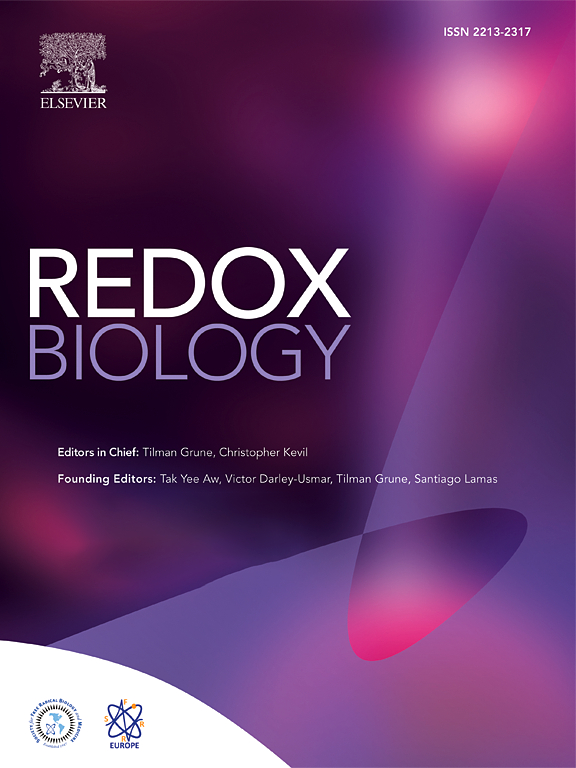FMRP 通过与 hnRNPM 相互作用促进 SLC7A11 的替代剪接,从而保护乳腺癌细胞免于铁变态反应。
IF 10.7
1区 生物学
Q1 BIOCHEMISTRY & MOLECULAR BIOLOGY
引用次数: 0
摘要
铁中毒是一种独特的细胞死亡调节模式,由铁依赖性磷脂过氧化驱动。N6-甲基腺苷(m6A)RNA修饰参与了多种细胞过程。然而,m6A读写器脆性X智力迟钝蛋白(FMRP)是否参与了乳腺癌(BC)中的铁变态反应的调控仍是一个未知数。本研究发现,FMRP表达升高与乳腺癌患者的不良预后和病理分期有关。FMRP的过表达诱导铁变态反应抵抗,并通过正向调节关键的铁变态反应防御基因SLC7A11发挥致癌作用。从机理上讲,上调的FMRP可催化SLC7A11 mRNA的m6A修饰,并通过依赖METTL3的方式进一步影响SLC7A11的翻译。进一步研究发现,FMRP与剪接因子hnRNPM相互作用,识别剪接位点,进而调节SLC7A11转录本的外显子跳接事件。有趣的是,SLC7A11-S剪接变体能有效促进FMRP过表达诱导的BC细胞铁变态反应抵抗。此外,我们的临床数据表明,FMRP/hnRNPM/SLC7A11在肿瘤组织中的表达显著增加,而这一信号轴是与BC患者生存和预后恶化密切相关的重要评估因素。总之,我们的研究结果揭示了一种新的调控机制,即FMRP的高表达可保护BC细胞免于发生铁突变。靶向FMRP-SLC7A11轴具有抑制铁蛋白沉降抵抗和肿瘤生长的双重作用,可能是治疗BC的一个有前景的治疗靶点。本文章由计算机程序翻译,如有差异,请以英文原文为准。
FMRP protects breast cancer cells from ferroptosis by promoting SLC7A11 alternative splicing through interacting with hnRNPM
Ferroptosis is a unique modality of regulated cell death that is driven by iron-dependent phospholipid peroxidation. N6-methyladenosine (m6A) RNA modification participates in varieties of cellular processes. However, it remains elusive whether m6A reader Fragile X Mental Retardation Protein (FMRP) are involved in the modulation of ferroptosis in breast cancer (BC). In this study, we found that FMRP expression was elevated and associated with poor prognosis and pathological stage in BC patients. Overexpression of FMRP induced ferroptosis resistance and exerted oncogenic roles by positively regulating a critical ferroptosis defense gene SLC7A11. Mechanistically, upregulated FMRP catalyzes m6A modification of SLC7A11 mRNA and further influences the SLC7A11 translation through METTL3-dependent manner. Further studies revealed that FMRP interacts with splicing factor hnRNPM to recognize the splice site and then modulated the exon skip splicing event of SLC7A11 transcript. Interestingly, SLC7A11-S splicing variant can effectively promote FMRP overexpression-induced ferroptosis resistance in BC cells. Moreover, our clinical data suggested that FMRP/hnRNPM/SLC7A11 expression were significantly increased in the tumor tissues, and this signal axis was important evaluation factors closely related to the worse survival and prognosis of BC patients. Overall, our results uncovered a novel regulatory mechanism by which high FMRP expression protects BC cells from undergoing ferroptosis. Targeting the FMRP–SLC7A11 axis has a dual effect of inhibiting ferroptosis resistance and tumor growth, which could be a promising therapeutic target for treating BC.
求助全文
通过发布文献求助,成功后即可免费获取论文全文。
去求助
来源期刊

Redox Biology
BIOCHEMISTRY & MOLECULAR BIOLOGY-
CiteScore
19.90
自引率
3.50%
发文量
318
审稿时长
25 days
期刊介绍:
Redox Biology is the official journal of the Society for Redox Biology and Medicine and the Society for Free Radical Research-Europe. It is also affiliated with the International Society for Free Radical Research (SFRRI). This journal serves as a platform for publishing pioneering research, innovative methods, and comprehensive review articles in the field of redox biology, encompassing both health and disease.
Redox Biology welcomes various forms of contributions, including research articles (short or full communications), methods, mini-reviews, and commentaries. Through its diverse range of published content, Redox Biology aims to foster advancements and insights in the understanding of redox biology and its implications.
 求助内容:
求助内容: 应助结果提醒方式:
应助结果提醒方式:


